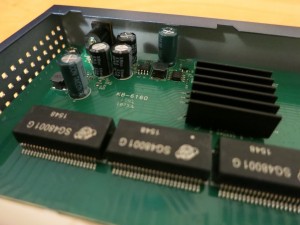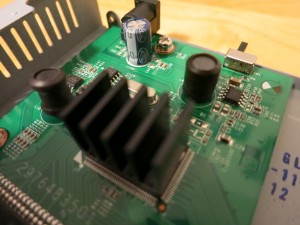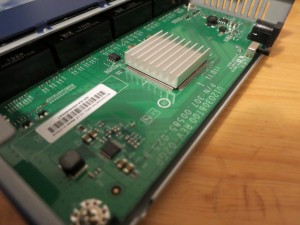Netgear’s ProSafe GS108 8-Port Gigabit Switch has been around for over ten years in various hardware versions – all of which have set the benchmark for simple, robust design and being nothing more than a reliable gigabit switch for your home, office, or business. Thing is, they aren’t exactly cheap. Let’s compare the newest ProSafe GS108 to two less expensive alternatives that all provide eight gigabit ports enclosed in a sturdy and professional metal chassis – the Netgear GS308 and the TP-Link SG108.

Features Comparison
Let’s take a look at some advertised features of each switch, which are all pretty much identical. In fact, the features listed on Amazon.com for both the Netgear GS108 and Netgear GS308 are exactly the same!
All three switches are non-blocking, which means they support 16Gbps of traffic (since all eight full duplex gigabit can move a gigabit of packets both ways).
The TP-Link advertises support for 12K jumbo frames, though all recent versions of the GS108 and all versions of the GS308 do indeed support 9K jumbo frames.
Netgear GS108 and GS308
- 8 auto-sensing 10/100/1000 Mbps Gigabit Ethernet ports
- Small and silent desktop form factor in a rugged metal case
- Plug-n-Play connectivity easily installs into any network
- LED to indicate activity on each port and energy-efficient technology for power savings
- Auto-negotiation for automatic connection at the highest common speed between switch and an end device
- Rigorously tested for reliability, built to last
- >Non-blocking switching architecture for maximum throughput at wire speed
- Auto-MDI/MDIX eliminates the need for crossover cables
TP-Link TL-SG108
- 12K Jumbo frame improves performance of large data transfers
- 8 gigabit port switch Ethernet connection integrates 10/100/1000Mps with Auto-Negotiation
- Plug and play no configuration required
- Innovative energy-efficient technology saves power up to 72
- Non-blocking switching architecture that forwards and filters packets at full wire-speed for maximum throughput
- IEEE 802.3x flow control provides reliable data transfer
- Fanless design ensures quiet operation
- Industry-leading 5-year warranty and unlimited technical support. Technical Support: +1 866 225 8139; Hotline en Français: +1 855 987 5465.
- 12K Jumbo frame improves performance of large data transfers
- 8 gigabit port switch Ethernet connection integrates 10/100/1000Mps with Auto-Negotiation
- Plug and play no configuration required
- Innovative energy-efficient technology saves power up to 72%
- Non-blocking switching architecture that forwards and filters packets at full wire-speed for maximum throughput
- IEEE 802.3x flow control provides reliable data transfer
- Fanless design ensures quiet operation
- TP-LINK Live 24/7 Technical Support
Warranty
The biggest difference on paper between the Netgear GS108 and GS308 is the warranty. The GS108 (marketed at businesses) has a lifetime warranty, while the GS308 (marketed for home and office use) only comes with a 2 year warranty.
In comparison to the Netgear products, the TP-Link switch (marketed for business use as well) has a 5 year warranty.
Packaging and Included Accessories
The Netgear GS108 and GS308 as well as the TP-Link switch simply include the switch itself, power supply, and documentation. While no ethernet cables are included, keep in mind that most people installing a switch already have cables or prefer to make their own. Including one would be handy, though, because too many ethernet cables is never a bad thing.
Something to note is that the Netgear GS308 already had the little rubber feet attached from the factory, the Netgear GS108 and TP-Link TL-SG108 don’t have them pre-installed – they come extra in a little baggy. If you’re a really, really lazy person you should probably buy the GS308.
While both Netgear switches use 12V power supplies @ 0.5A, the TP-Link is specced at 9V 0.6A. Personally I prefer the standard 12V setup since it’s easier to find a replacement adapter should the original one fail, and you don’t have to worry about an end user accidentally plugging in a 12V power supply into a 9V switch, which could damage it. If you do the math, 12V x 0.5A = 6W, and 9V x0.6A = 5.4W, so all three switches should be similar in power usage. We shall see later if this really is the case.
All three switches are wall mount capable, though only the Netgear GS108 included the little plastic things that go in the wall and two screws.
Performance
Although I don’t have the time or resources to test if all of the switches can actually do 16Gbps of switching (which would mean doing an upload test and download test on eight different computers at the same exact time), I devised to following simple test to try to benchmark each switch: I transferred a large file from both computers to each other at the same time three different times, and averaged the speeds.
Keeping in mind that there’s always some overhead in terms of drivers and software, expecting exactly 125MBps (1000Mbps) would be unrealistic. As such, all three switches performed almost identically (as they should have) and there is no real world difference between the TP-Link SG108, Netgear ProSafe GS108, and the Netgear GS308. The results were so close and within the margin of error for my testing procedure that I’m not even going to waste your time or mine with a chart.
Power Consumption
Here’s another place I was going to make a chart, but all three of the new switches used the same minimal amount of power, as accurately as I could measure with my simple “kill-a-watt” power meter. The new Netgear ProSafe GS108 (v4), GS308, and TP-Link TL-SG108 all used about 1 watt when idle, and when busy they used about 3 watts.
For comparison, I measured an older version of the Netgear ProSafe GS108 (v2), and got 4 watts idle and 6 watts busy.
Clearly all the new switches have been redesigned with energy efficiency in mind. The lesson here is that no matter what new switch you pick, the age of the switch matters more than the brand and model.
Build Quality
Here’s the fun part – taking stuff apart is always enjoyable and informative. We’ll get to see if there is any actual internal difference between the Netgear GS108 and Netgear GS308, and see how the quality of the much cheaper TP-Link switch compares. The best part is that none of these switches have any warranty seals, so it probably won’t void the warranty to disassemble them. That said, I’m doing this so you don’t have to – while it’s always possible different batches of the switches can use different components and you might have a different hardware version of the switch, these samples I purchased at retail should provide great insight into the quality of parts and construction of the units.
TP-Link TL-SG108
With a metal chassis and metal ports, the switch feels sturdy, though the glossy finish doesn’t feel as professional as either of the Netgear switches.
Internally, the TP-Link has a reasonable sized heatsink on the ASIC.
The most common port of failure in most types of compact fanless network equipment that I’ve observed over the years is the electrolytic capacitors. While all caps will dry out eventually when they pass their rated lifespan, there are three main ways their lifespan is impacted: good design of the circuit, operating temperature, and quality of capacitors used.
While I can’t easily analyze the quality of the design nor the exact temperature at which these capacitors operate, I would expect them to last at least the five years since that is the warranty period on this switch, but if used in a hot environment, not much more than that. All that aside, I personally would have preferred the switch cost a dollar more and have used better quality capacitors from a company like Panasonic or Rubycon instead of the Taicon (well known to be an inferior quality part) and SM (never heard of it) capacitors used in the TL-SG108, but I also understand that this is a much cheaper priced switch than the two competing Netgear products, so I’m really not too disappointed.
Netgear GS308
Despite the GS308’s higher price tag when compared to the TP-Link, it uses plastic ethernet ports. While it isn’t a big problem, I would have liked to see metal ports. On the other hand, the Netgear’s textured finish does feel more solid than TP-Link’s.
Internally, the Netgear GS308 doesn’t impress me. The circuit board only uses part of the space inside the metal chassis, which by itself isn’t a problem, but it means that all the heat from that heatsink is right next to the single capacitor inside the switch, an Ltec. To me, this explains why Netgear only put a two-year warranty on this switch – in most cases it probably doesn’t matter but if you use it heavily in a hot environment that capacitor is more likely to fail than the more spacious design of the TP-Link, even though Ltec caps are not any better or worse than the Taicon and SM parts TP-Link used in their TL-SG108.
Netgear GS108
I opened up the GS108 expecting to see generic electrolytic capacitors like older versions of this switch I’ve opened up in the past, and the other two switches in this roundup. Instead, there weren’t any – at all! Let me reiterate that for you – the most likely component to fail in these switches simply isn’t present – which means that the switch should pretty much last forever.
While I don’t know exactly how the Netgear GS108 is doing the filtering, since both the GS108 and GS308 came with the exact same model power supply, it exceeds my expectations and demonstrates that the ProSafe GS108v4 is a clear improvement over previous versions (I just opened a GS108v2 I’ve owned for a few years and found Teapo capacitors inside, eww).
I suspect that it costs Netgear less to use quality components in a switch that they put a lifetime warranty on than to save a few cents up front simply to have to pay to process the RMA a few years down the road, so it’s obvious why Netgear would make this choice, but what it means to you is that that the new GS108 switch (in theory) should be slightly more reliable than both Netgear’s own GS308 and TP-Link’s TL-SG108.
The GS108 uses the same chassis as the GS308, except it’s blue not gray.
Value and Conclusion
From analyzing the advertised features, our own performance benchmarks, and taking each switch apart to see how well they are built and the quality of components used, we’ve come to the following conclusions.
- My recommended switch from here on out (I’ll be buying these for the foreseeable future for myself and client installs) and the best value is the TP-Link TL-SG108, since it’s costs only $25 and overall is designed and constructed better than the more expensive Netgear GS308. It also has a five year warranty, which, while not as good as the Netgear GS108 that costs double the price, is better than the two year warranty the middle-priced GS308 has. Buy the TP-Link TL-SG108 on Amazon.com.
- The second best value of the three switches is the Netgear ProSafe GS108, which retails for $49. For almost double the price of the TP-Link switch and almost $20 more than Netgear’s own GS308, it’s definitely the most expensive by far, but a lifetime warranty and electrolytic-capacitor-less design mean that you can’t beat it for long-term reliability. However, keep in mind you could buy two TP-Link TL-SG108s for the price of one Netgear ProSafe GS108, which is why the GS108 isn’t my top pick for overall value. Buy the Netgear GS108 on Amazon.com.
- The worst value is the Netgear GS308. At $32, this switch costs more than the cheaper TP-Link, it’s ethernet ports are plastic instead of metal, and has a short two-year warranty. I’d only recommend this switch if you have a budget conscious client that refuses to buy anything but Netgear, the TP-Link is out of stock, or you’re only using it in a well cooled environment. Buy the Netgear GS308 on Amazon.com.



Thanks for this review and analysis of these devices, especially going into the weeds a bit with the capacitor stuff. Got to the point, highlighted the significant differences and ignored stuff that was basically the same.
Thanks for this detailed review. Ended up getting the GS108 since we’re in a business environment and price isn’t as sensitive. This switch will push a lot of data at night with backups and such where it’s going (unfortunately couldn’t convince them to install several new ports where this is needed, so, hence, needed this extra switch).
Actually they changed the internals of newer GS108 switch and now there have capacitors as well. No reason now to invest more into Netgear.
Two new GS108s (v4, rev.17) just arrived to me. Still no capacitors on board.
Thanks for the detailed review, could you share how you opened up the TP-Link SG108? I have one in front of me and I removed the 2 screws on the bottom but can’t get the top off.
Thanks
Thanks for this excellent run-down of the pros/cons of each device. Very insightful, and helped me figure out which I’d like to buy.
Thanks I have been searching for this review! I think a lot of people (or just me) assumed the gs108 and gs308 were nearly identical inside and the value you get is in the warranty only… NOPE. You proved that wrong by a long shot. I think Netgear realized their mistake and it is now generally priced BELOW the TP LINK
Thanks for this review.
On Friday, I had ordered a Netgear GS308 from Amazon.ca
However, it looked like they may not have been able to deliver until September 6th (about 6 or 7 weeks away).
After finding this review, I cancelled the order and ordered the TP-Link TL-SG108 8-Port Switch.
Cost me an extra $2, but no big deal.
Amazon informs me that my new Switch will be here by 9PM tonight…
No capacitors in the switch may signify they are in the charger brick, find an old one break it open gently with a hammer on the glued seamline of the brick assembly, you’ll see them. I replaced a bunch of 2Wire DSL Gateway chargers (their legacy white DSL modems) after busting open the chargers I found swelled capacitors.I replaced many of those power supplies because of this. I’m not sure it’s a better idea to have capacitors sealed up in a plastic enclosure with no ventilation where heat buildup is much more of a problem.
100%, generally its always the power supply to go out, on my personal equipment i use better quality power supplies than when they come with. And always with a higher amperage ratting, both for better stable voltages and longevity. eBay otoscope FTW! Lol
I’ve used the GS308 for 4 years now and I love it. With traffic on 1-3 computers transferring 250MB-45GB files between computers simultaneously the Windows 10 max speeds I’ve hit are 112MB-113MB/sec. That’s served me well and I’ve been quite happy.
I do say it is time to upgrade due to the larger files I’ve been using lately with video cameras so it’s time to look into 10GBe networking.
The Netgear Prosafe GS108 is only half duplex.
There are 4 largish capacitors clearly visible in the GS108 power supply. They are surface-mount ceramic capacitors (the brownish parts). Newer switch mode voltage regulators operate at much higher frequencies and so they can use smaller capacitors which makes it feasible to use ceramic capacitors rather than low ESR aluminum electrolytics. The good news is that ceramic capacitors don’t degrade and fail over time the way aluminum electrolytics do, so the thrust of your analysis is still correct!